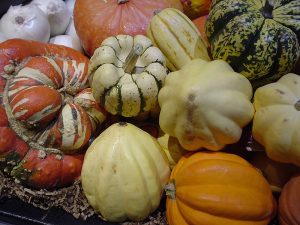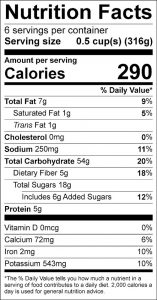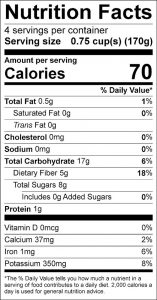Bulletin #4176, Vegetables and Fruits for Health: Winter Squash and Pumpkins
 Revised and updated by Associate Extension Professor Kathleen A. Savoie, University of Maine Cooperative Extension.
Revised and updated by Associate Extension Professor Kathleen A. Savoie, University of Maine Cooperative Extension.
Originally developed by Extension Nutrition Specialist Nellie Hedstrom, University of Maine Cooperative Extension.
For information about UMaine Extension programs and resources, visit extension.umaine.edu.
Find more of our publications and books at extension.umaine.edu/publications/.
Winter squash will keep for several months after harvesting. Winter squash is always eaten cooked. Most varieties have orange flesh that is slightly sweet with a nutty flavor. Maine-grown winter squash is available September through February. The following are all varieties of winter squash: acorn, butternut, buttercup, hubbard, and spaghetti.
A type of winter squash, pumpkins come in many sizes, from miniature varieties of one pound or less, to giant, prize-winning varieties of 300 to 400 pounds! The traditional round, deep-orange pumpkins used for carving jack-o’-lanterns on Halloween are not the best kind to use for cooking because they tend to be stringy and too moist. The small, dull orange, skinny variety called the sugar pumpkin has more pulp and is better to use for cooking. Maine-grown pumpkins are available in September and October.
Nutrition Information
The deep yellow to deep orange colors of pumpkin and winter squash show that they contain carotene, which your body turns into the antioxidant vitamin A. Other varieties of winter squash provide more vitamin A per serving than pumpkins. All varieties of winter squash are good sources of potassium, which is helpful in maintaining a healthy blood pressure.
Selection
Squash: Choose full-sized, mature fruit with a hard, tough rind. Also look for squash that is heavy for its size. Avoid squash with cuts, punctures, or sunken or moldy spots on the rind. A soft rind means that the squash is not mature and therefore not good to eat.
Pumpkin: Choose pumpkins that are firm, heavy, brightly colored, and free from blemishes. Avoid dull-colored pumpkins that have shriveled skin, soft spots, cuts, or breaks.
Storage
Store pumpkins and winter squash in a cool, dry place. If you store them outdoors, make sure there is no danger of frost.
Preparation
Steaming: Both pumpkins and winter squash are excellent steamed. Peel and cut into two-inch cubes, and steam 25 to 40 minutes, until fork-tender. Or steam large pieces with the rind left on. Once cooked, the rind can easily be removed. To steam, bring one inch of water to boil in the bottom of a pan. Place a colander or a collapsible steaming basket in the pan. Then put the vegetables in the colander or steamer and cover it tightly. Reduce heat to medium-low, but make sure it is high enough to keep the water bubbling.
Add a dash of nutmeg to the cooked pumpkin or squash. Serve cubed or mashed.
Baking: Wash small, whole squash, such as acorn or butternut varieties. Cut in half and remove the seeds and fibers. (For an extra treat, you can save the seeds, wash them, add a little salt or cinnamon and sugar, and toast in your oven at 350 degrees F for 20 minutes.) Bake the halves at 400 degrees F for one hour or more. (Larger squash should be cut into individual portions to shorten baking time.) To shorten baking time, bake halves covered for the first 30 minutes. Then take the cover off for the rest of the baking time.
Microwaving: Squash and pumpkin cook much more quickly in the microwave than in the oven. For small squash, such as acorn, cut lengthwise. Scoop out seeds and fibers. Cover each half with plastic wrap and arrange in oven with space between. Microwave at high power five to eight minutes per half. Then let stand covered, for five to ten minutes. For larger squash and pumpkins, cut into individual portions. Arrange in microwave-safe dish. Cover with plastic wrap. Cook three to four and a half minutes per piece. After half the cooking time has passed, rotate the dish so that the squash cooks evenly. Then let stand, covered, for five minutes.
Pumpkin Rice with Apricots
 This delicious side dish is a good source of fiber, antioxidants, and vitamin A.
This delicious side dish is a good source of fiber, antioxidants, and vitamin A.
Serves 6
3 cups cooked brown rice
1/4 cup margarine
1 cup chopped onions
6 cups peeled, seeded, and diced sugar pumpkin
1 cup chopped dried apricots
1/2 teaspoon salt
3 tablespoons brown sugar
1 cup chicken broth
1 cup slivered almonds (optional)
In a saucepan cook rice following package directions. In another saucepan melt margarine over medium heat, and stir in the onions. Slowly cook and stir onions until soft. Mix in the pumpkin, apricots, salt, brown sugar, and one cup chicken broth. Cook 20 minutes. Then, mix rice into the pumpkin mixture and continue cooking 10 minutes, or until pumpkin is tender (or serve pumpkin mix over rice bed. Add almonds before serving.
Squash Apple Casserole
 This is a wonderful vegetable dish, especially for holidays. It is high in vitamin A, a good source of vitamin C, cholesterol-free, and almost sodium free.
This is a wonderful vegetable dish, especially for holidays. It is high in vitamin A, a good source of vitamin C, cholesterol-free, and almost sodium free.
Serves 4
2 1/2 cups fresh winter squash, cut into 1/2-inch slices
1 1/2 cups cooking apples, pared and cut into 1/2-inch slices
1 teaspoon cinnamon
1/2 teaspoon nutmeg
Alternate layers of squash and apples in an 8- x 8-inch pan, ending with apples on top layer. Sprinkle spices over top layer. Cover pan with aluminum foil and bake in 350 degree F oven for approximately 45 to 60 minutes, until squash is tender. Remove foil and bake another 10 to 15 minutes to remove any excess liquid that might have accumulated. Cool slightly before serving.
Some content adapted with permission from University of Massachusetts Cooperative Extension.
Information in this publication is provided purely for educational purposes. No responsibility is assumed for any problems associated with the use of products or services mentioned. No endorsement of products or companies is intended, nor is criticism of unnamed products or companies implied.
© 2008
Call 800.287.0274 (in Maine), or 207.581.3188, for information on publications and program offerings from University of Maine Cooperative Extension, or visit extension.umaine.edu.
The University of Maine is an EEO/AA employer, and does not discriminate on the grounds of race, color, religion, sex, sexual orientation, transgender status, gender expression, national origin, citizenship status, age, disability, genetic information or veteran’s status in employment, education, and all other programs and activities. The following person has been designated to handle inquiries regarding non-discrimination policies: Sarah E. Harebo, Director of Equal Opportunity, 101 North Stevens Hall, University of Maine, Orono, ME 04469-5754, 207.581.1226, TTY 711 (Maine Relay System).

